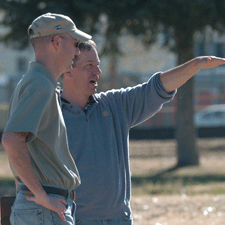Before last weekend, Ed Mate had never ventured south of the U.S.-Mexico border, much less visited South America. But his horizons are expanding in a big way this week as the CGA’s executive director gets an Olympic-related moment in the spotlight.
With golf returning to the Olympics in 2016 after a hiatus of 112 years, a decision will be made late this week about who will design the official course for the Summer Games in Rio de Janeiro, Brazil.
Eight design teams are each making 45-minute presentations in Rio this week, and some of the biggest names in golf will be involved, including Jack Nicklaus and Annika Sorenstam (one team), Greg Norman and Lorena Ochoa (another) and Gary Player.
Among the others making a bid is Tom Doak, head of Renaissance Golf. And that’s where Mate becomes involved as he’ll be part of Doak’s presentation team. Doak and Mate (right and left, respectively, in photo) worked together when Doak and Renaissance Golf designed CommonGround Golf Course, the facility that is owned and operated by the CGA and CWGA. The public course, located in both Denver and Aurora, opened in May 2009.
A while back, Mate wrote a letter on behalf of the CGA and CWGA supporting Doak’s Olympic bid, and Doak was impressed enough with Mate and his thoughts that he invited the executive director to accompany him in Rio. Mate departed for Brazil on Saturday and will return on Friday. The four-person committee that’s hosting the course designers is expected to announce its selection by Friday.
“I was shocked — very flattered, but mainly shocked” about being invited, Mate said recently after scrambling to update his travel documents. “I’ve never been south of the equator, so I plan to make the most of it. But this is definitely a real honor.”
Mate admits he’s daydreamed a little about what it might be like in the hours leading up to this week’s presentations.
“I’ve thought about it — how it would be interesting to be in a waiting room chatting with Greg Norman, Annika or Jack,” he said with a laugh, admitting he doesn’t know how things will be set up in Rio.
All that aside, Mate will be on hand because he’s obviously a big believer in Doak, having been part of a group that selected him to design CommonGround after interviewing several other finalists.
Doak certainly has some eye-opening credentials in the design business. Of Golf Magazine’s list of the top courses in the world, five of Doak’s designs are in the first 80: Pacific Dunes in Bandon, Ore. (19), Cape Kidnappers in New Zealand (33), Barnbougle Dunes (with Mike Clayton) on the Australian island of Tasmania (41), Old Macdonald in Bandon (74) and Ballyneal here in Colorado (79).
And when lists are limited to “modern” courses, Doak’s work figures in even more prominently. In Golfweek’s rundown of the best modern courses in the U.S., Doak’s layouts have five spots in the top 15: Pacific Dunes (2), Old Macdonald (3), Ballyneal (6), Sebonack (with Nicklaus) in Southampton, N.Y. (8), and Rock Creek Cattle Company in Deer Lodge, Mont. (15).
And, of course, CommonGround is regarded highly enough that it will serve as the second stroke-play course for this year’s U.S. Amateur, which is being hosted by Cherry Hills Country Club. By the way, Doak and Renaissance Golf oversaw a major restoration project at Cherry Hills several years ago.
“When it comes to course design, no one can claim more than him,” Mate said of Doak. “Winning championships, he can’t compete, but as far as (course design) work goes, he’s eminently qualified. He has a lot of courses in the top 100.”
Twenty-four design teams submitted the necessary paperwork to be considered for the Olympic project, but that number was cut to eight in early December. In addition to Doak, Nicklaus/Sorenstam, Norman/Ochoa and Player, the finalists for the job are Gil Hanse, Martin Hawtree, Robert Trent Jones II/Mario Gonzalez and Peter Thomson/Ross Perrett/Karrie Webb. Thomson, a five-time British Open winner, joins Nicklaus, Sorenstam, Norman, Ochoa, Player and Webb as winners of major championships.
After serving as the Olympic venue for both men’s and women’s golf competitions, the Rio de Janeiro course is expected to operate as a public facility with a teaching academy, a consideration which also will factor into this week’s selection.
The winning designer will receive a relatively modest fee of $300,000, though the accompanying media attention for working on such a high-profile project could be a big boon.
As Doak noted in an e-mail for a Wall Street Journal story, “It’s a rare chance to define (or redefine) what a great championship course is supposed to be, on a very big stage.”
Groundbreaking for the Olympic course is scheduled to take place in October.


